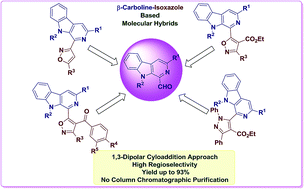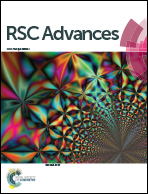Metal-free 1,3-dipolar cycloaddition approach towards the regioselective synthesis of β-carboline and isoxazole based molecular hybrids†
Abstract
Nature has nourished β-carboline and isoxazole derivatives as privileged scaffolds and consequently they are ubiquitously found in alkaloids isolated from various sources. Moreover, several drug molecules based on them have been released in the market. Considering their immense impact, novel β-carboline–isoxazole-based molecular hybrids have been designed and a 1,3-dipolar cycloaddition strategy was devised to prepare the desired prototypes. A library of compounds with a wide range of diversity have been developed by employing β-carboline-containing dipolarophiles as well as dipoles. The current method represents a simple, efficient and easy-to-execute protocol towards the regioselective synthesis of β-carboline–isoxazole conjugates.

- This article is part of the themed collection: Elegant Synthetic Routes to Indole Derivatives

 Please wait while we load your content...
Please wait while we load your content...